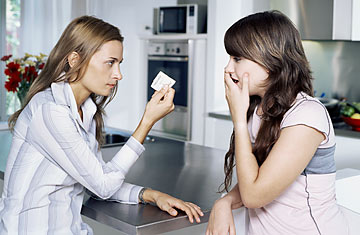
(4 of 10)
The policy of Planned Parenthood in New York City is typical. Before
1968 it gave birth control information to unmarried teen-age girls only if they already had had a child. Observes Executive Vice President Alfred Moran: "We were saying, in effect: 'We'll be glad to provide protection if you buy the ticket of admission—one pregnancy.' " Realizing the illogic of that position and swept along with the "new ethos," the organization now serves almost everyone and estimates that nearly 40% of its new patients are 19 or under.
At Manhattan's Margaret Sanger Research Bureau, clinic workers include teen-agers like Kathy Hull, 17, who gets course credits at her Brooklyn high school for volunteering. Chocolate cookies are passed around at the rap sessions that patients attend before they are examined and given contraceptives; boy friends are invited to the meetings and may even be present at the pelvic examinations if their girl friends agree. Said one who did: "He held my hand, and I was glad he cared enough to be there."
Dolls with Breasts. What brought about the new sexual freedom among teenagers? "Obviously," nine parents out of ten would probably say, "it's all this permissiveness." But permissiveness is just a word that stands for many things, and as with most societal changes, it is often difficult to tell what is cause and what is effect. One major factor is the "erotization of the social backdrop," as Sociologists John Gagnon and William Simon express it. American society is committed to sexuality, and even children's dolls have breasts and provocative outfits nowadays. Another frequently cited factor is the weakening of religious strictures on sex. Observes Social Critic Michael Harrington: "One of the great facts about our culture is the breakdown of organized religion and the disappearance of the inhibitions that religion once placed around sexual relationships." Sociologists have found an inverse relationship between churchgoing and sexual experimentation: the less of the former, the more of the latter. In fact, suggests Sociologist Ira Reiss, today's teen-agers may have more influence on religion than the other way round. Among liberal clergymen, at least, there is something of a scramble to keep up with youthful ideas on sex. Permissive Catholic priests let their views become known and so in effect encourage liberated youngsters to seek them out for confession. Unitarian churches give courses for 12-to 14-year-olds "About Your Sexuality," complete with frank lectures and discussions, as well as films showing intercourse, masturbation and homosexuality.
Diminishing family influence has also shaken up the rules. The disillusionment of many youths with Viet Nam, pollution and corruption has sexual side effects, say Simon and Gagnon. It reinforces the idea of the older generation's moral inferiority. In fact, the two sociologists assert, many young people begin sexual activity in part as a "personal vendetta" against their parents. Nor does the older generation have a very good record of marital stability. Since
